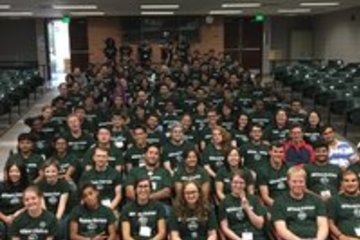Browse
Youth Empowerment
Data Tag Implementation (Article for QA)
The following organizational supports are particularly useful. Students should be taught to use these tools through teacher modeling and guided practice with feedback before being expected to use them more independently.
By:
Anne miller New vijayalaxmi santosh mhetre mali
Tuesday, Jan 11, 2022
YOUTH EMPOWERMENT

Leave a comment
ADHD Students and Classroom Considerations
The culture of the classroom can either support or create barriers to student success (Piffner,2011).
Factors that foster attention, positive behavior, and academic and social success includeestablishing positive relationships with students, adopting classroom management techniques,and creating a physical arrangement that facilitates learning.
It is often a positive relationship with one teacher that facilitates school success for a studentwith ADHD (Piffner, 2011).
When teachers connect with students and appreciate their unique skills and interests, students are more likely to strive for achievement and positively respond to classroom rules and procedures.
When using a proactive approach to classroom management, teachers support all students andcreate conditions that prepare them for learning (Piffner, 2011).
Some strategies for positive management include clear directions, meaningful feedback, and opportunities for collaboration with peers. Here are some others.
Opportunities to RespondStudents with ADHD often have the most trouble attending during drill-and-practice assignments because of the repetitive nature of the tasks. Peer-mediated approaches such as those enumerated in the next screens are particularly effective for students with ADHD in such cases, because they increase students’ opportunities for engagement and active learning (Piffner, 2011).
In creating peer-mediated activities, the teacher may need to choose students whoseskill levels complement each other. Students with and without attention difficulties andimpulsivity should be considered for peer partnerships.
By:
Anne miller New vijayalaxmi santosh mhetre mali
Tuesday, Jan 11, 2022
YOUTH EMPOWERMENT

Leave a comment
U.S. Embassy Bamako Public Diplomacy Annual Program Statement
Introduction
PAS Bamako invites proposals for projects that strengthen ties between the United States and Mali by promoting bilateral cooperation and highlighting shared values and shared interests. All programs must advance one of the key priorities listed below and must promote an element of American culture or have a connection with American expert/s, organization/s, or institution/s in a specific field that will promote increased ties between the United States and Mali and foster understanding of U.S. policies and perspectives. The PAS Small Grants program is NOT a vehicle to fund development projects, nor can these grants be used to support for-profit entities.
Examples of PAS Small Grants Program projects include, but are not limited to:
Artistic and cultural workshops, joint performances, and exhibitions
Academic and professional lectures, seminars, and speaker programs
Cultural heritage conservation and preservation programs
Civic engagement and social activism programs
Key Priority Areas and Audiences
The purpose of projects funded under the annual program statement is to strengthen ties between Americans and Malians as we work together to make progress toward the goals outlined below.
Strengthening independent media and fighting disinformation through media literacy, training and other engagement;
Reinforcing existing Sister City relationships or other relationships between U.S. and Malian institutions (e.g. universities or museums)
Ensuring participation of citizens, especially women and youth,
in the democratic process;
Fostering economic growth and entrepreneurship;
By:
Anne miller New vijayalaxmi santosh mhetre mali
Friday, Dec 24, 2021
YOUTH EMPOWERMENT
+2

YOUTH EMPOWERMENT
+1
Thursday, Dec 23, 2021

Leave a comment
Students with ADHD
Primer text from The College of William & MaryADHD is one of the most commonly diagnosed conditions of children (Centers for DiseaseControl and Prevention, 2015).
In a 2016 Centers for Disease Control and Prevention study, scientists found that 6.1 million children aged 2-17 years living in the U.S. had been diagnosed with attention-deficit/hyperactivity disorder (ADHD), which is similar to previous en
Ages 6-11: Approximately 2.4 million children
Ages 12-17: Approximately 3.3 million children
The diagnostic term attention deficit/hyperactivity disorder (ADHD) refers to individuals who display patterns of inattention, impulsivity, and overactive behavior that interfere with daily functioning (American Psychiatric Association [APA], 2013).
The Diagnostic and Statistical Manual (DSM) V (APA, 2013) criteria for diagnosing ADHD listthree types of ADHD and the accompanying characteristics.
By:
Anne miller New vijayalaxmi santosh mhetre mali
Wednesday, Dec 22, 2021
YOUTH EMPOWERMENT
+2

Leave a comment
Agile knowlege
Process improvement is continuous improvement. We can never reach perfection. In this tutorial, we will learn CMM that is a continuously evolving and improving model where the focus is always on doing better. Our reach should always exceed our grasp.
What is CMM?
CMM stands for Capability Maturity Model.
Focuses on elements of essential practices and processes from various bodies of knowledge.
Describes common sense, efficient, proven ways of doing business (which you should already be doing) − not a radical new approach.
CMM is a method to evaluate and measure the maturity of the software development process of an organization.
CMM measures the maturity of the software development process on a scale of 1 to 5.
CMM v1.0 was developed by the Software Engineering Institute (SEI) at Carnegie Mellon University in Pittsburgh, USA.
CMM was originally developed for Software Development and Maintenance but later it was developed for −
Systems Engineering
Supplier Sourcing
Integrated Product and Process Development
People CMM
Software Acquisition
CMM Examples
People CMM − Develop, motivate and retain project talent.
Software CMM − Enhance a software focused development and maintenance capability.
What is Maturity?
Definitions vary but mature processes are generally thought to be −
Well-defined,
Repeatable,
Measured,
Analyzed,
Improved, and
Effective.
Poor but mature processes are just as bad as no maturity at all!
CMM helps to solve the maturity problem by defining a set of practices and providing a general framework for improving them. The focus of CMM is on identifying key process areas and the exemplary practices that may comprise a disciplined software process.
Immature vs Mature Organization
An immature organization would have the following characteristics −
Process improvised during project
Approved processes being ignored
Reactive, not proactive
Unrealistic budget and schedule
Quality sacrificed for schedule
No objective measure of quality
In contrast, the characteristics of a mature organization are as follows −
Inter-group communication and coordination
Work accomplished according to plan
Practices consistent with processes
Processes updated as necessary
Well-defined roles/responsibilities
Management formally commits
What is CMMI?
CMM Integration project was formed to sort out the problem of using multiple CMMs. CMMI product team's mission was to combine three Source Models into a single improvement framework for the organizations pursuing enterprise-wide process improvement. These three Source Models are −
Capability Maturity Model for Software (SW-CMM) - v2.0 Draft C.
Electronic Industries Alliance Interim Standard (EIA/IS) - 731 Systems Engineering.
Integrated Product Development Capability Maturity Model (IPD-CMM) v0.98.
CMM Integration
Builds an initial set of integrated models.
Improves best practices from source models based on lessons learned.
Establishes a framework to enable integration of future models.
Difference between CMM and CMMI
CMM is a reference model of matured practices in a specified discipline like Systems Engineering CMM, Software CMM, People CMM, Software Acquisition CMM etc., but they were difficult to integrate as and when needed.
CMMI is the successor of the CMM and evolved as a more matured set of guidelines and was built combining the best components of individual disciplines of CMM(Software CMM, People CMM, etc.). It can be applied to product manufacturing, people management, software development, etc.
CMM describes about the software engineering alone where as CMM Integrated describes both software and system engineering. CMMI also incorporates the Integrated Process and Product Development and the supplier sourcing.
CMMI and Business Objectives
The objectives of CMMI are very obvious. They are as follows −
Produce quality products or services − The process-improvement concept in CMMI models evolved out of the Deming, Juran, and Crosby quality paradigm: Quality products are a result of quality processes. CMMI has a strong focus on quality-related activities including requirements management, quality assurance, verification, and validation.
Create value for the stockholders − Mature organizations are more likely to make better cost and revenue estimates than those with less maturity, and then perform in line with those estimates. CMMI supports quality products, predictable schedules, and effective measurement to support the management in making accurate and defensible forecasts. This process maturity can guard against project performance problems that could weaken the value of the organization in the eyes of investors.
Enhance customer satisfaction − Meeting cost and schedule targets with highquality products that are validated against customer needs is a good formula for customer satisfaction. CMMI addresses all of these ingredients through its emphasis on planning, monitoring, and measuring, and the improved predictability that comes with more capable processes.
Increase market share − Market share is a result of many factors, including quality products and services, name identification, pricing, and image. Customers like to deal with suppliers who have a reputation for meeting their commitments.
Gain an industry-wide recognition for excellence − The best way to develop a reputation for excellence is to consistently perform well on projects, delivering quality products and services within cost and schedule parameters. Having processes that conform to CMMI requirements can enhance that reputation.
By:
Edwin Castel
Wednesday, Dec 22, 2021
CULTURE AND SOCIETY
+2
Leave a comment
Life Course Model for Treatment of ADHD
We previously proposed a model for treatment of ADHD that emphasizes a life-course perspective to address the long-term implications and outcomes of early life experiences on health, psychological, and educational outcomes of individuals with ADHD across the life span (Evans, Owens, Mautone, DuPaul, & Power, 2014). In contrast to prevailing models of care that focus on service delivery to individuals emphasizing short-term symptom reduction, the life-course model prioritizes helping youth with ADHD improve competencies and develop into independent, healthy adults who achieve occupational, personal, and recreational success. Briefly, this model is comprised of four layers of services including (1) foundational strategies to establish appropriate structure and supports in home and school (e.g., parent-teacher communication), (2) psychosocial interventions to increase competencies and address impairments in academic, behavioral, and social functioning (e.g., organization interventions), (3) medication treatment, and (4) accommodations to adapt environments to children’s limitations (i.e., reductions in expectations). These layers represent the sequence within which services should be delivered and combined over time and across systems and settings.
By:
rupali
Tuesday, Nov 16, 2021
YOUTH EMPOWERMENT
+1

Leave a comment
Multiple psychosocial interventions are efficacious for children and adolescents with attention-deficit/hyperactivity disorder (ADHD) including behavioral parent training, behavioral classroom management, behavioral peer interventions, and organization training programs. Unfortunately, there is a significant gap between research and practice such that evidence-based treatments often are not implemented in community and school settings. Using a life course model for ADHD treatment implementation, we discuss future research directions that support movement from the current, fragmented system of care to a more comprehensive, integrated, and multi-systemic approach. Specifically, we offer six recommendations for future research. Within the realm of treatment development and evaluation
By:
rupali
Tuesday, Nov 16, 2021
AGRI-FOOD SYSTEMS
+6

Leave a comment
Technology integration is the use of technology tools in general content areas in education in order to allow students to apply computer and technology skills to learning and problem-solving.
By:
rupali
Monday, Sep 27, 2021
YOUTH EMPOWERMENT
Leave a comment
Technology integration is the use of technology tools in general content areas in education in order to allow students to apply computer and technology skills to learning and problem-solving. Generally speaking, the curriculum drives the use of technology and not vice versa.
By:
rupali
Monday, Sep 27, 2021
CULTURE AND SOCIETY
+2



Leave a comment